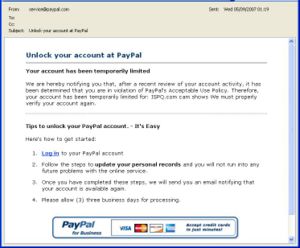Phishing: Difference between revisions
imported>Anton Sweeney m (→Method: typo in filename?) |
imported>Anton Sweeney m (→Method: change caption, resize) |
||
| Line 4: | Line 4: | ||
==Method== | ==Method== | ||
[[Image:Phishing.JPG|thumb|right| | [[Image:Phishing.JPG|thumb|right|300px|Screenshot of a typical phishing email. purporting to be from ''[[Paypal]]''. The sender's address has been faked.]] | ||
The fraudsters will first set up a [[website]] designed to mimic that of their target financial institution. Then, using a [[bot network]] or other similar means, they will send a carefully constructed [[email]] to a massive number of recipients. The email will use copied [[logo]]s, embedded in the mail, to give the appearance that it is coming from the financial institution in question. | The fraudsters will first set up a [[website]] designed to mimic that of their target financial institution. Then, using a [[bot network]] or other similar means, they will send a carefully constructed [[email]] to a massive number of recipients. The email will use copied [[logo]]s, embedded in the mail, to give the appearance that it is coming from the financial institution in question. | ||
Revision as of 05:28, 5 September 2007
Phishing is the computer industry term used to describe a type of fraud in which the victim is encouraged to divulge personal confidential information, such as an account username and password for an online banking or financial service. The term, with its unusual spelling, derives from the associated but older term phreaking, which refers to hacking into telephone systems.
A typical phishing attempt uses social engineering techniques to prey on the fears of uninformed users of online financial systems. By tricking such users into divulging their account credentials, the fraudsters can then access the compromised accounts and transfer the funds therein to a holding account, which will then be quickly emptied.
Method

The fraudsters will first set up a website designed to mimic that of their target financial institution. Then, using a bot network or other similar means, they will send a carefully constructed email to a massive number of recipients. The email will use copied logos, embedded in the mail, to give the appearance that it is coming from the financial institution in question.
While many of these mails will be caught by spam filters and other protections, some will make it through to the mailboxes of people who have accounts with the target financial institution. A person clicking on one of the links contained in the email will be brought not to the financial institution's website, but to the fake one that has previously been set up. If the mail recipient does not notice that they are at a fake site and enters their credentials, the fake site will record these details. The fraudsters can then access the account themselves and empty it of funds.